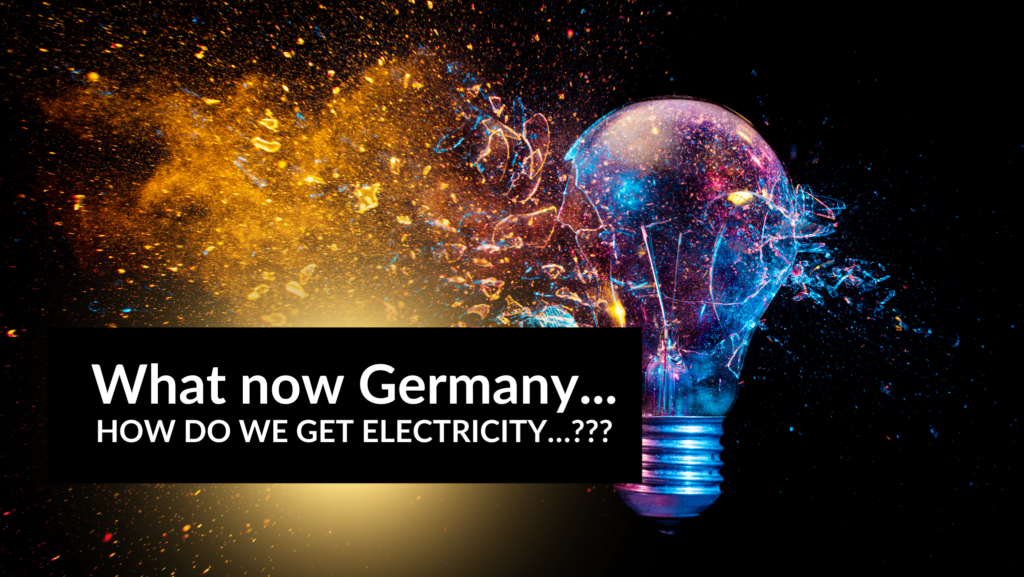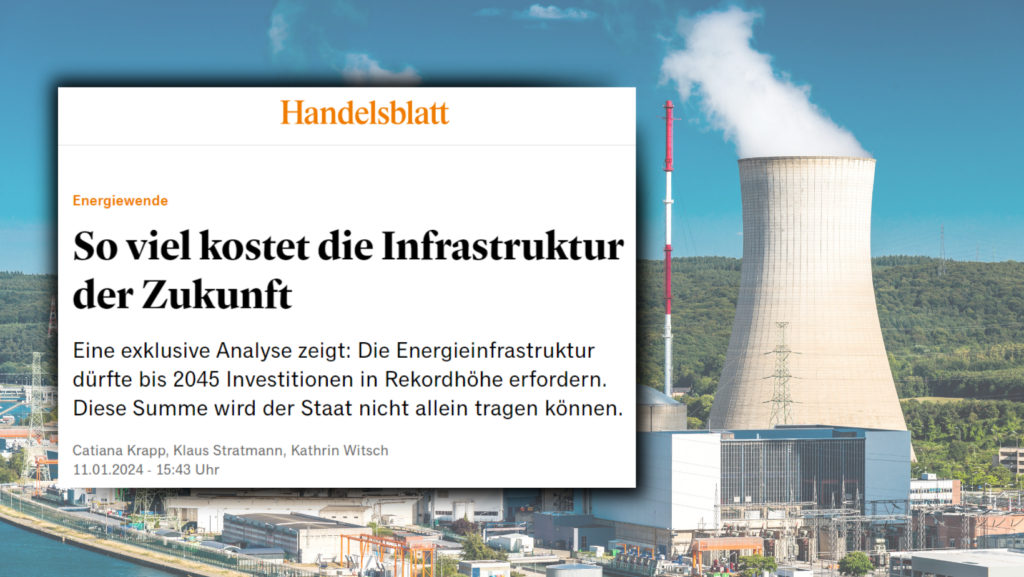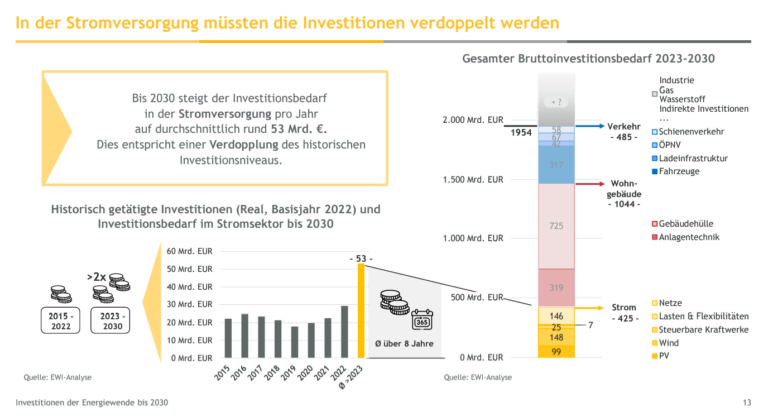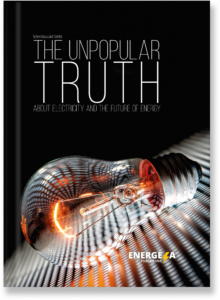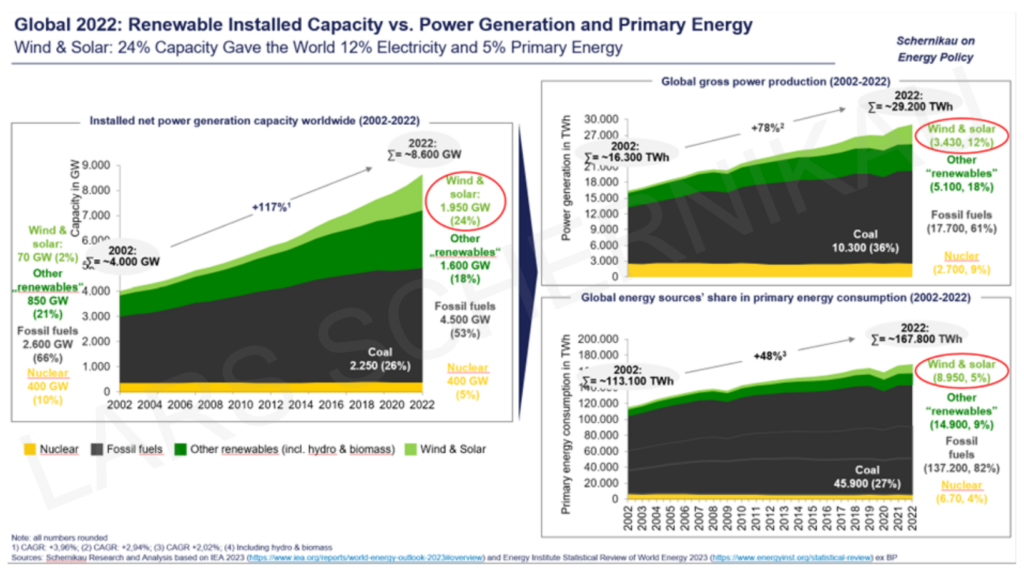“Germany’s heavy industry is worse off now than during the worst COVID times”…True or False?
True… of course, the high gas and coal prices of 2022 have something to do with it… they were high because of Putin, which affected Germany as it doubled its “energy transition-related” dependence on Russian gas over the last 20 years.
Or maybe we should consider that coal and nuclear power were gradually reduced, or maybe because energy security was not really taken seriously, or because the sun doesn’t shine at night and the wind doesn’t always blow?
The Germany energy news is … as German policymakers and energy industry leaders face enormous challenges due to a recession, deindustrialization and more, the country continues to work to meet ambitious renewable energy goals amidst an unfolding energy crisis.
I recently came across this graph from Destatis, the Federal Statistical Office, and it made me feel rather queasy. Read in German.
Germany must invest over €2 trillion to keep “green” promises…True or False?
True… According to EWI’s analysis, dated Oktober 2023, Germany must indeed invest over €2 trillion – or €2,000 billion – through 2030 to keep its “green” promises. This staggering figure almost dwarfs the €1.1 trillion through 2045 (under) estimated by Handelsblatt in January 2024. The EWI or “Energiewirtschaftliches Institut” is a German “thinktank”, an Energy Economics Institute, run by the prestigious University of Cologne.
Honestly, both numbers mentioned are so staggeringly high that, the “small” gap of €0.06 trillion or €60 billion, that the German government is currently grappling with, almost doesn’t seem that significant any longer.
As Germany’s energy reports seem to be ignoring a looming reliability crisis, the goals to phase out nuclear and coal power, and reduce reliance on Russian natural gas imports have pushed the country’s “energy transition” into uncharted territory.
The EWI’s study provides important insights into the investments required across the electricity, transportation, buildings, and industrial sectors to enable Germany’s shift to a “clean energy” future. However, successfully navigating the transition will require more than just massive capital outlays.
Fundamental questions remain about integrating high levels of renewable energy, replacing baseload power plants, electrifying large portions of transport and heating, securing raw materials and grid infrastructure, and most importantly how do we get electricity and industries to the people in a reliable, affordable and sustainable manner?
Today… I will summarize some of the EWI’s key findings, provide constructive critique, and outline the multifaceted challenges Germany faces regarding its energy system. Let´s take a closer look shall we…
Share this blog
Key Findings from EWI’s report on the Cost of the German “Energy Transition”
A report dated October 2023 by the Energy Economics Institute (EWI) lays out the staggering investment required for Germany to meet its climate goals by 2030. According to the EWI study, over €2 trillion will need to be invested by 2030 across the electricity, transportation, buildings, and industrial sectors. This eye-popping €2 trillion figure is significantly higher than the €1.1 trillion required by 2045 (under) estimate published January 2024 by Handelsblatt.
The EWI study provides a detailed sector-by-sector breakdown:
Close on €2,000 billion in “investments” will be necessary by 2030 alone (€240 bn per year, calculated from 2022, € 270 bn from 2023)…
- Electricity sector: €425 billion
- Transportation sector: €485 billion
- Buildings sector: over €1 trillion
- The industrial sector was not fully quantified in the study, meaning the actual investment is higher when factoring in expenses for industrial gas, hydrogen, and indirect investments. Even excluding the uncertainties around industry, the scale of the transition outlined is unprecedented.
According to the Institute, immediate action would be required, along with a doubling of current investment levels in “renewables”…
Lars´ Constructive Critique of the EWI Study
The EWI study makes several assumptions and has stated limitations that are important to highlight.
1. Methane emissions and other non-climate related environmental factors. For example, not considered is that LNG is “worse for the climate” than coal if one accepts IPCC and IEA data as correct.
2. Investments in supply chain and infrastructure. The study also does not account for the substantial investments be required in supply chain infrastructure, facilities such as ports, and the sourcing of raw materials, and the energy required to build the renewable capacity outlined. The €2 trillion figure reflects only direct technology investments, not the wider system changes needed to support deployment at such a massive scale so quickly. This likely underestimates the true cost by a wide margin.
3. Investment in skilled professionals (or even just the matter of administration) makes the timeline of mobilizing these investments by 2030 seem rather “ambitious”. Transforming investments into complex energy facilities in just over 6 years is a monumental challenge, as evidenced by past infrastructure projects like the Berlin Airport which took 15 years to complete costing €7 billion instead of the originally planned €2 billion.
4. Benefits of affordable energy, as well as the capital required for keeping the country´s industry and manufacturing from running away (see “Industrial Electricity-Price-Support Debate )
a. Or in other words, the disadvantages resulting from such a €2 T program for Germany’s economy and its residents
b. Aspects such as financing or the impact on interest rates,but inflation is highlighted as a “challenge” in the EWI’s report.
5. Ecological disadvantage resulting from the huge amounts of energy, raw materials, and land utilization required for wind and solar and other industrial capacity:
a. Wildlife and plants (flora and fauna)
b. Warming due to the energy required to build these installations.
c. Warming due to large-scale wind and solar installations?
(see Harvard, Nature, Environmental Research Letters , and Geophysical Research Letters)
In summary… while the EWI’s study provides a starting point, its stated focus underestimates the wider implications and challenges of Germany’s proposed “energy transition”. I recommend a macro-economic and more comprehensive analysis considering all known issues for policymakers and voters.
Now What Germany?
I don’t really know either... I dare state, with high probability, bordering on certainty that
(a) the above mentioned cannot and will not occur,
(b) if it were to take place, that it would cost at least twice as much if one was honest about the entire supply chain and all externalities.
I must add that no economic benefits for Germany from the above investments have been considered, which would surely exist? For example, the money must go somewhere, and that “somewhere” would generate profits. Only where these profits are generated is not quite clear yet. Remember that China controls the manufacturing of “renewable technologies” and most raw materials processing.
I would also like to point out that according to McKinsey, the EWI and the German government around €60 billion is needed to build 30 GW of gas-fired power plants by 2030 (50 very large power plants). If these power plants are not built, the lights will go out… unless of course Germany refrains from shutting down coal-fired power plants, which I strongly recommend, or France has a lot of unused spare nuclear power during the winter, which I personally doubt.
A few words about gas
- The German Government Budget currently assumes that the country will support “hydrogen-ready” gas-fired-power-plants, largely fueled by imported LNG, with €7.5 billion of tax payer’s money
- Where the remaining €50+ billion would come from is unclear to me, since those power plants can clearly not run profitably, since they are only “backup” and will rarely run. This short 2 min video will show you what it looks like to be such a plant on Bavaria.
- But then again, today in 2024, Germany already has a “Hydrogen-ready” power plant operational in Leipzig capable of 123MW (0.2% of what is required in 6.5 years)… and Germany’s gas import capacity… well, let’s not get into the details…
Lars’ recommendations
My pressing recommendations on how to get electricity to the people in an affordable, reliable and sustainable way, are clearly explained in our book “The Unpopular Truth about Electricity and the Future of Energy”
a. We urgently need to invest in conventional technologies such as coal, gas, oil, refineries, nuclear power, and more… to make them cleaner and more efficient.
b. We need to stop grid-scale wind, solar and hydrogen immediately. I know that’s uncomfortable to hear, but the book explains why it’s necessary… from an economic and environmental point of view… otherwise it will get much worse and more expensive.
c. In parallel, we need to invest in R&D to truly secure a sustainable energy future and to reduce our dependency on oil, coal and gas. Only then can we start exploring other options for point (a)
d. We urgently need to stop using “CO2” as the basis of every and all calculations, and finally start looking at the overall environmental and economic impact of our activities across the entire supply chain and life-cycle
e. Please let’s invest, even just a fraction of these trillions, into poverty reduction, education and child development, environmental protection, physical and mental health, and much more… let’s start talking openly and honestly about our lifestyles and our energy system, which in Germany and worldwide is 80% dependent on oil, coal, and gas.
Final words
You can see nicely how coal (26% of global power plant capacity) provides for 36% of global electricity and 27% of global primary (total) energy.
you can also see how wind and solar (24% of global power plant capacity) provides for 12% of global electricity but only 5% of total energy… something doesn’t add up, does it?…
… of course you cannot see in the graph that every single one of those wind turbines or solar panels require a backup or storage, that sits idle when wind and solar “work”.
Share this blog

